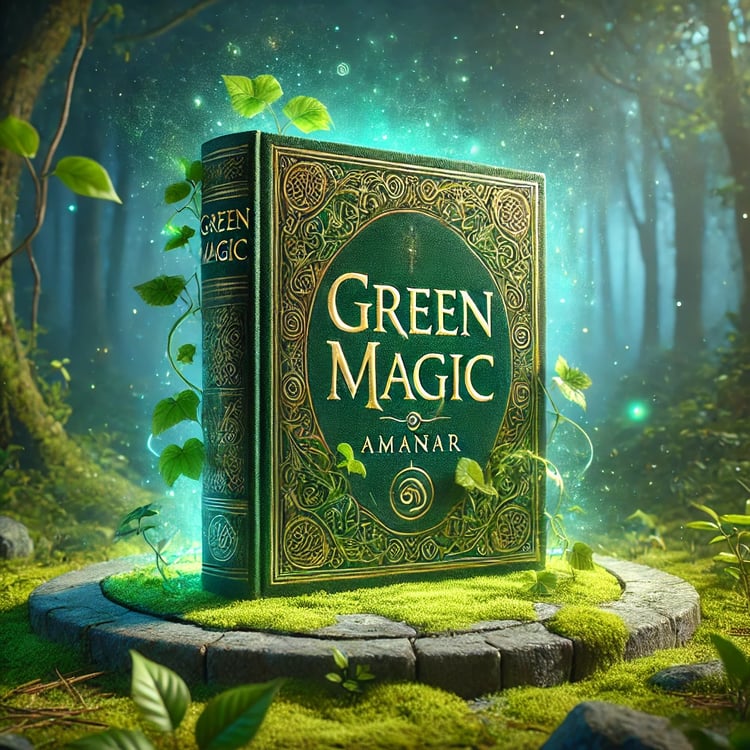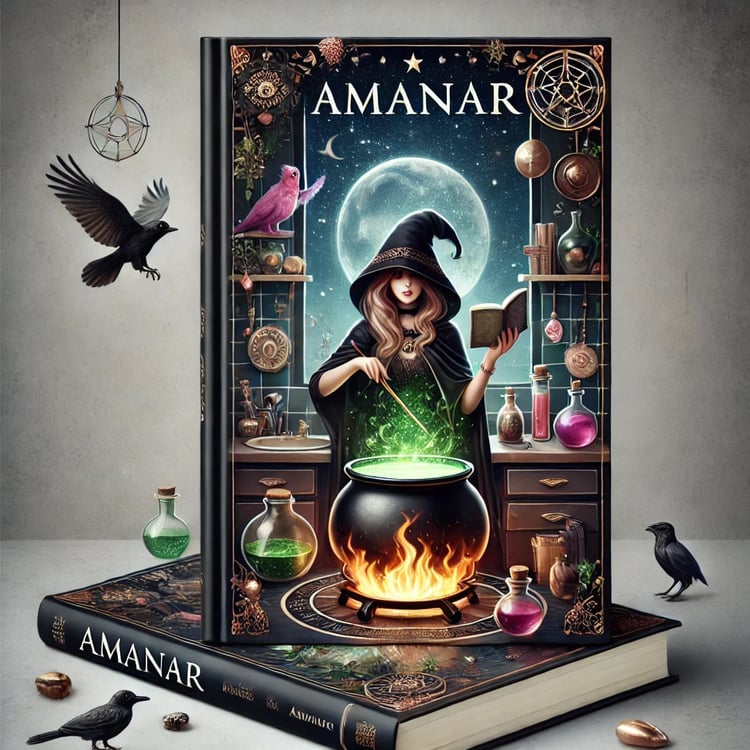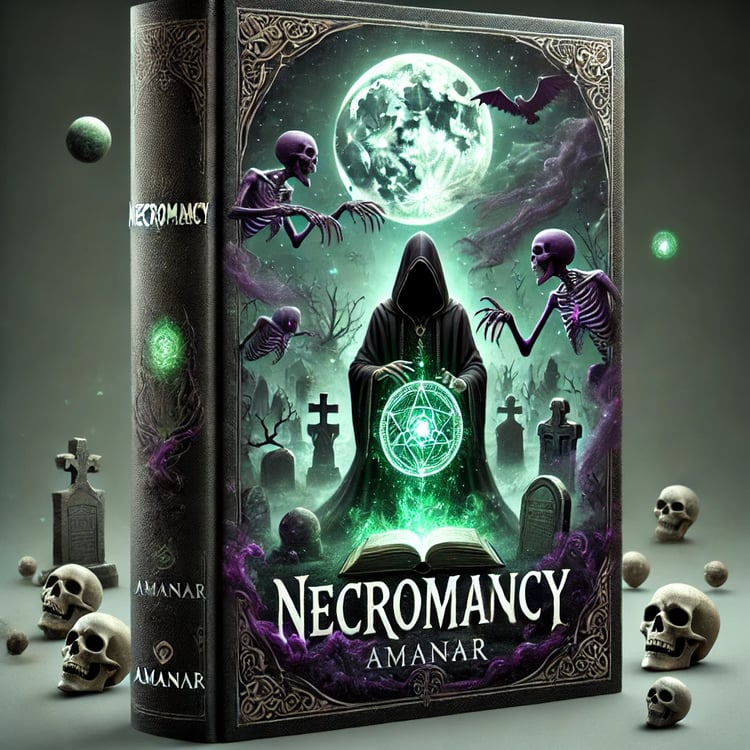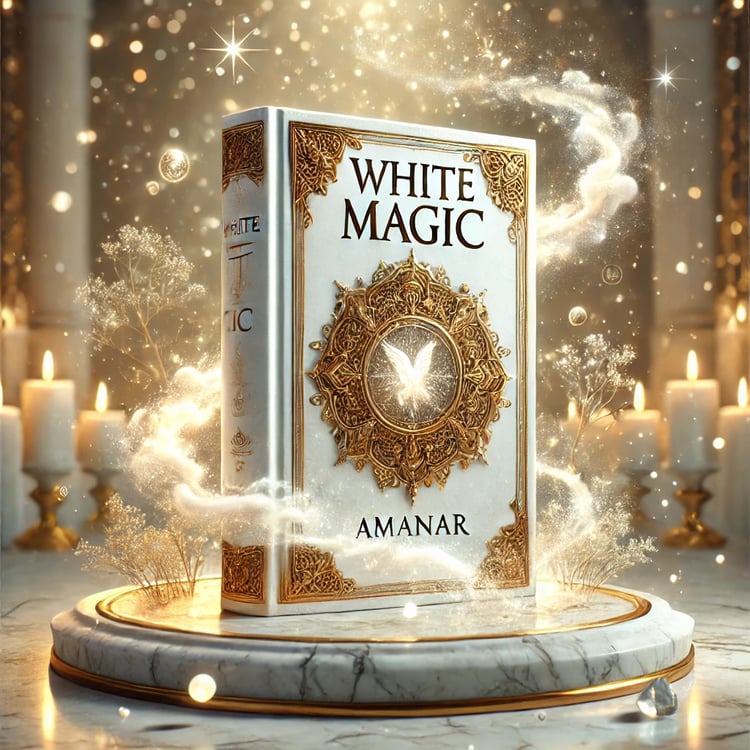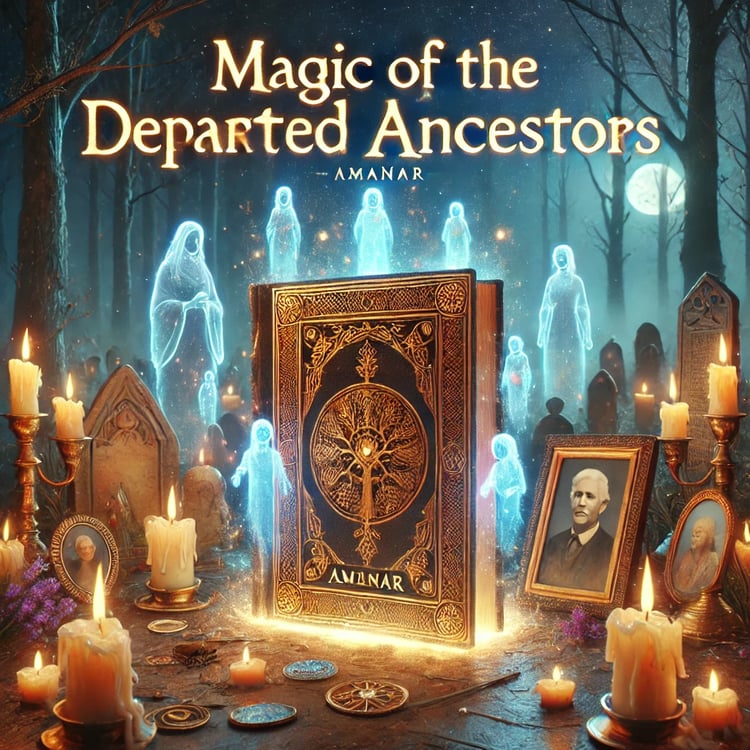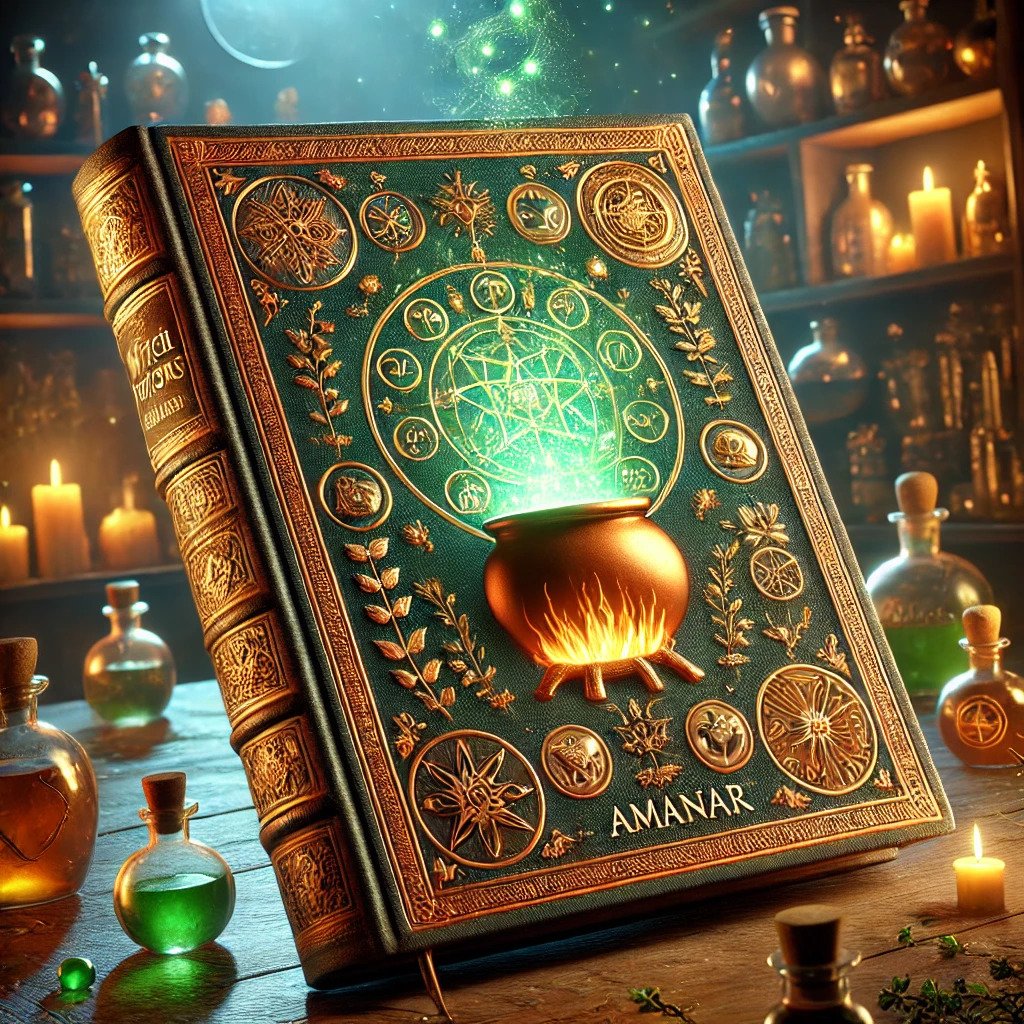
Amanar "Witchcraft Potions and Remedies"
Chapter 1
In this opening chapter, the adept is introduced to the foundational currents of mystical brewcraft, wherein ancient herbal knowledge and the arcane wisdom of the ages intertwine. Here, the lineage of potioneers is traced through the veiled corridors of medieval Europe, across the shadowy enclaves of rural witchcraft, and into the secret groves of Kabbalistic scholarship. The craftsman of elixirs shall learn to attune both mind and spirit to the subtle vibrations of plants, stones, and whispers in Latin and Sumerian that echo through forgotten grimoires. Old rites of purification stand revealed, laying the groundwork for the seeker to handle both benign concoctions and those potent philters that border on the forbidden. Reflections upon the four elemental powers—Earth, Air, Fire, and Water—set the stage for the creation of potions that resonate with each realm. Beneath the moon’s pale glow, new initiates will prepare their first basic tinctures, forging a sacred bond between the aspirant and the realm of spirits that dwell within each brew.
Chapter 2
Unfolding deeper mysteries of the Craft, this chapter guides the student through the labyrinth of ceremonial rites that fortify the potency of each potion. Drawing upon arcane texts written in archaic tongues, the aspirant learns to chant incantations in Latin, Sumerian, and other cryptic languages, ensuring the conjured energies remain properly sealed within every elixir. The synthesis of European witchcraft and Kabbalistic insight reveals hidden structures of the cosmos, allowing the careful practitioner to weave astral correspondences into each mixture. Within the dim sanctum of the apothecary’s hearth, the seeker delves into the practice of fumigations and blessèd waters, comprehending how incense and sanctified dew empower the fledgling brew. Warnings and protections are not neglected, for malevolent forces lurk in the shadows, waiting to taint the unwary. Here, one learns to ward their workspace through sigils, amulets, and meticulously drawn circles of power.
Chapter 3
In this section, the aspiring potion-maker learns the importance of the planets and their astrological movements, for the tides of destiny flow through each constellation as they influence the creation of magical concoctions. The old masters of Western magic knew well the significance of timing, waiting for Saturn’s hour to brew poisons of banishment or for Venus’s favor to craft a passionate elixir of love. The text beckons the reader to consult meticulous star charts and heed the cryptic words of ancient oracles, ensuring the synergy between the cosmic currents and the potion’s purpose. Hints of voodoo traditions surface, instructing how offerings to ancestral spirits can amplify the brew’s effectiveness, while Kabbalistic sephiroth provide a symbolic framework to guide the practitioner through subtle realms. Invocations in archaic tongues stir these celestial energies, summoning their essence into the cauldron at the correct juncture of heaven’s dance.
Chapter 4
Here are unveiled the arcane secrets of base ingredients—roots, herbs, minerals, and essences of curious origin—that form the bedrock of potent potions. The chapter opens the codex of long-forgotten harvest rites, chanting the archaic calls that once echoed in the hidden groves of druidic enclaves. Each plant is alive with its own guardian spirit, and the adept must learn the gentle art of entreating these vital forces, lest the brew turn sour or the spirits unleash their wrath. Tales from European folklore harmonize with the deeper knowledge of African diaspora traditions, weaving a tapestry of cunning knowledge. Riddles in ancient scripts guide the brewer toward the correct planetary day or hour, ensuring the gleaned ingredients radiate with optimum power. Within this chapter, the careful student shall begin to compile their personal grimoire of raw materials, forging sacred ties that will deepen with every harvest.
Chapter 5
Delving into the realm of transformation and alchemical transmutation, the student encounters the subtle interplay of sulfur, mercury, and salt—the prime trifecta at the heart of old alchemical treatises. Through incantations whispered in the lamplit hush of midnight, the brewer learns to unite these primordial elements, infusing potions with the soul of living forces. Whether conjuring an ethereal brew for astral travel or forging a healing draught to banish mortal afflictions, the adept must engage the living essence in each step. Old European conjurations merge with Kabbalistic diagrams to illustrate the process, while shards of voodoo practice remind the seeker that every transformation must be approached with reverence. Within these pages, cryptic references to Sumerian chants are presented as keys to unlock deeper realms of potency. The mind, the flame, and the stirring spoon become one, an alchemical triad that births wonders and miracles in the swirling depths of the cauldron.
Chapter 6
In this chapter, the focus shifts to protective potions and banishing brews, drawing upon the austere rites of Western ceremonial magic to guard hearth and soul. The text expounds on the mysterious art of forging wards within the steaming depths of a simmering concoction. Each drop is woven with the power to repel malevolent spirits, hexes, and nightmares that plague the unsuspecting. The brewer learns to ground the mixture in Earth’s stability and harness the luminous flames of holy Fire, all while whispering incantations gleaned from a tapestry of ancient languages. The spirit world’s guardians are invoked, from kindly house-spirits of European lore to ancestral guides revered in voodoo traditions, each offering an added layer of vigilance. Though the process demands concentration and devotion, the reward is a shielded existence, unmolested by curses or ill-intended energies. Carefully hidden from prying eyes, these formulae become a bulwark of the wise.
Chapter 7
Moving beyond mere defensive spells, the adept now explores potions of empowerment and enhancement, crafted to bolster the will, sharpen psychic awareness, and open the gateways of inner vision. Building upon the knowledge gleaned so far, the chapter reveals how to harness energies from the waxing moon, the elemental guardians, and the watchers at the threshold to infuse each draught with vigor. The bridging of voodoo invocation and Kabbalistic resonance forms an exalted practice, aligning personal vibration with higher spiritual forces. Latin conjurations, mingled with whispered Sumerian phrases, call forth the astral currents that can grant clarity or awaken dormant magical gifts. The text further offers cautionary tales of overindulgence and the moral responsibilities that come with heightened power. The wise brewer must balance these new capabilities with humility and an unwavering respect for cosmic order, lest the next sip bring calamity instead of ascent.
Chapter 8
Here, the interplay of love and desire is summoned through the smoke of incense and the swirl of crimson liquids in the moonlit chamber. This chapter unveils the subtle intricacies of attraction potions—brews that kindle passion, mend broken hearts, or strengthen existing bonds through the harmonization of energies. Rooted in the age-old traditions of European folk magic and echoing with the sensual undertones of voodoo lore, each recipe resonates with the magnetism of Venus, the siren calls of the sea, and the enchantments of whispered Latin verses. Powerful Sumerian incantations can bind the hearts of lovers with cosmic threads, though practitioners must tread lightly, for meddling in matters of free will courts the disfavor of mighty spirits. Soft candlelight and sweet herbs become the gates to a realm where the human heart’s desires are laid bare. From gentle attraction charms to fervent love-laden draughts, the brewer learns both the exhilaration and the peril of conjuring romance.
Chapter 9
Nighttime emerges as a shroud for secret rites in this chapter dedicated to dream potions and slumbering illusions. Within those twilight hours, the membrane separating mortal consciousness and the spirit realm grows thin. A careful reading of forbidden tomes reveals how to infuse nighttime beverages with herbs known for their visionary qualities. Latin chants are whispered as the steam curls skyward, opening conduits to astral journeys and revelations from the hidden planes. Voodoo insights instruct the brewer in the summoning of spirit-guides who linger in the realm of dreams, granting prophecy or counsel. Yet caution must be observed, for nightmares can be woven just as easily as visions of truth. An inattentive chant or a single wrong ingredient may unleash illusions that cling to the waking mind like dark cobwebs. In this delicate interplay of psychic exploration, the dreamer seeks knowledge but must guard against ephemeral snares.
Chapter 10
This chapter plunges into the realm of necromantic potions and communications with the spirits of the departed, delving into a domain both feared and revered. Drawing upon the silent pages of ancient funerary texts, the adept learns to combine powerful herbs, charred remains, and cryptic sigils to forge concoctions that bridge life and death. Sumerian incantations echo alongside older-than-time Latin supplications, inviting the restless shades to share their wisdom. With European witchcraft practices as a scaffold, the brewer sets out to form pacts with the beyond, discovering that each ancestor or spirit holds a unique key to hidden knowledge. The text also warns of the pitfalls: restless ghosts, vengeful wraiths, and unspeakable horrors that lurk in the void between worlds. The wise conjurer steps lightly in these corridors of the afterlife, ensuring that each communion is approached with solemn respect, holy wards, and a heart fortified against the dread of the grave.
Chapter 11
Turning from the somber realm of the dead, the journey ascends into the radiant territories of healing potions and restorative elixirs. Within these pages, old folk remedies blossom into true magical art through the synergy of Kabbalistic insight, voodoo healing chants, and whispered Latin prayers for divine intercession. Infusions of rose, lavender, and other sacred botanicals are prepared in harmony with planetary cycles, ensuring that cosmic currents of beneficence flow into each brew. Ceremonial acts of blessing form the core of the practice, calling upon angelic guardians and gentle ancestral spirits to guide the curative process. Physical ailments, emotional wounds, and spiritual imbalances alike find restoration when the ingredients are combined with devotion and focused intention. Tread carefully, for the line between remedy and poison can be perilously thin. A single misstep in measurement or timing might invert healing into harm. Thus, the adept must remain ever attentive, lest mercy become malice.
Chapter 12
In this passage, the keen-minded brewer uncovers the lost art of illusions, hallucinogenic philters, and potions meant to bend perception. The texts refer to an array of European carnival spells and masked ceremonies where illusions were conjured for revelry or subterfuge. Blended with voodoo dreamcraft and Sumerian calls to the ephemeral watchers of the ether, these potions become gateways to distorted realities and labyrinthine visions. Through cunning blendings of rare flowers, venom extracts, and the astral forces invoked by archaic intonations, illusions can be shaped to reveal the unseen, lure the unsuspecting, or cloak the conjurer’s presence. Yet these be the potions of shadows, beckoning with seductive power. Those unprepared for the swirling landscapes of fear and ecstasy shall find themselves lost in the illusions they have woven. Thus, the text emphasizes the need for unwavering grounding and humility when daring to mold the fabric of perception.
Chapter 13
Pacts with elemental spirits, and the forging of potions that channel their raw force, lie at the heart of this chapter. Earth, Water, Air, and Fire become living presences, bound by incantations gleaned from primal cultures and whispered in lost languages. From the moorlands of Celtic Europe to the blazing altars of Western ceremonial magic, the wise adept learns the virtues and dangers each element embodies. A brew infused with Earth’s power can stabilize and strengthen, granting resilience of body and spirit, while an elixir dedicated to Water calls forth emotional depth and psychic empathy. Air’s potions bring clarity and swiftness of thought, but may detach the brewer from mortal concerns. The potions of Fire ignite determination and passion but carry the risk of uncontrollable fury. Through ritual offerings and carefully inscribed sigils, the elemental lords are appeased, ensuring that the potions they bless remain loyal servants rather than tempestuous masters.
Chapter 14
Steeped in the old ways of cunning-folk and folk healers, this chapter explores the art of disguise and transformative potions. Shrouded in secrecy, these brews have historically served as keys to shapeshifting or adopting the guise of a beast, a spirit, or another human face. Here, fragments of European bestiaries intertwine with references to African shapeshifting legends and Sumerian mythic beasts, beckoning the adventurous to slip beyond human boundaries. Some transformations last only as long as moonlight drenches the night sky, while others might linger, tempting the unwary soul to forget its original form. Whispered Latin formulas bind the shape to the magician’s will, but the text warns of those who lose themselves to the primal call. The line between freedom of form and captivity to dark impulses grows razor-thin. Each potion demands an offering, a test of resolve, and a willingness to tread paths seldom walked by mortal feet.
Chapter 15
Venturing into the domain of voodoo-infused potions, this chapter presents the traditions passed down from Haitian, New Orleans, and other diaspora lineages, merging them with threads of Western occultism. The creation of “hot foot” mixtures to drive away troublesome presences stands side by side with potions designed to call upon the loa for guidance, protection, or favor. The adept learns the sanctity of ritual drumming, ancestral reverence, and how best to honor the spirits before placing requests. Herbs grown under tropical suns reveal a power distinct from the flora of Europe, and their synergy with incantations whispered in Haitian Creole, Spanish, or Latin forms potent bonds. Old European grimoires now share space with the keepsakes of voodoo queens, forging a living tradition. Yet respect is paramount, for the spirits can be fierce, and arrogance in their presence courts certain downfall. The brewer must proceed with humility, bearing gifts and sincerity of heart.
Chapter 16
A dive into the labyrinth of Kabbalistic potions illuminates the mystical framework of the Tree of Life, casting each potion as a reflective vessel for the sephiroth and the hidden paths that connect them. Hebrew invocations unite with Latin litanies, weaving an elevated tapestry of divine and earthly forces in each brew. The adept is taught to ascend the Tree in silent meditation, gathering the essence of each sephira—mercy, severity, wisdom, beauty—and condensing their energies into philters that can heal, enlighten, or catalyze profound spiritual growth. Threads of European ceremonial magic guide the practical application, ensuring that each brew resonates harmoniously with the cosmic order. Yet one must also account for the qliphoth, the husks of fallen power that lurk beneath the Tree’s radiant canopy. The text warns that each ascent has a corresponding descent, each blessing a potential curse. By balancing these energies in the cauldron, the adept becomes an agent of cosmic equilibrium, forging potions that reflect the infinite interplay of darkness and light.
Chapter 17
Here, the text plunges into the domain of curses and hexing potions, a subject often cloaked in moral and spiritual warnings. The ancient witches of Europe, the malicious bokor of voodoo lore, and the darkest chambers of ceremonial magic all left behind cryptic formulas for potions intended to harm, bind, or unravel the destinies of foes. Detailed instructions pass along the significance of graveyard dirt, venomous plants, and the echo of Latin maledictions that sear the aura of the intended target. Sumerian inscriptions might be carved into wax effigies or chanted before the brew is sealed, calling upon primordial forces of chaos. The text, however, upholds that such knowledge must be handled with the utmost discretion and awareness of karmic or spiritual repercussion. For every ill stirred into the cauldron, a shadow may return to haunt the conjurer. The wise brewster, therefore, weighs necessity against consequence when stepping into this perilous territory.
Chapter 18
This chapter offers a path of redemption and cleansing, revealing how to reverse curses, dispel hexes, and restore harmony through specific potions and ritual immersions. European folk magic, with its purifying baths of hyssop and juniper, meets voodoo rites of cleansing by river water and eggs to absorb malevolence. Kabbalistic psalms are woven into Latin hymns, forming prayers that break the chains of darkness. The adept learns to mix potent brews that wash away ill-wrought energies when drunk or used in ritual ablutions, employing the grace of angels and benevolent spirits. Each recipe emphasizes the vital necessity of contrition, forgiveness, and the willingness to release any grudges that might anchor a hex to the soul. Just as the conjurer can weave harm, so too can they unravel it, embodying the principle of balance. This chapter’s potions serve as beacons of light in the gloom, offering renewal and spiritual liberation.
Chapter 19
Turning the eye toward prosperity, this chapter addresses potions crafted to attract good fortune, wealth, and opportunity. Embedded in both medieval European grimoires and African diaspora traditions, these brews derive their potency from gold flakes, magnetic sands, and chants invoking celestial powers of abundance. Prayers to planetary intelligences are whispered in Latin or Hebrew, commanding the astral gates to open a stream of blessings upon the supplicant. A synergy emerges with voodoo lamp spells and offertory rites, illuminating the shadows of poverty with a glow of promise. Yet the text reminds the adept that pure intention and generosity often serve as catalysts, lest greed corrupt the brew and draw misfortune in disguise. By attuning the heart to gratitude and mindful stewardship, the potions become conduits of genuine prosperity, forging a harmonious link between the magician’s aspirations and the good will of the unseen realms.
Chapter 20
Here, a study unfolds of potions that serve to empower ritual tools, altars, and sacred spaces, imbuing them with longevity and a heightened spiritual charge. Drawing on centuries of esoteric knowledge, the adept blends rare resins, precious oils, and finely ground crystals into a thick, fragrant compound. Chanting archaic verses in Latin or Sumerian, the magician breathes life into the mixture, seeing it as an anointing essence. Western ceremonial constructs are strengthened with lines of sacred geometry, while European witchcraft lore teaches the placement of potent charms and sigils around the perimeter of the workspace. Voodoo contributions underscore the significance of ancestral blessings, calling upon the living memory of those who walked the path before. When carefully sprinkled or painted upon talismans and altars, these potions magnify the bond between the human and the divine. Such potent consecrations ward off intrusions, ground the practitioner, and create a resonant field in which all further magic thrives.
Chapter 21
As the book’s culmination nears, this chapter addresses the forging of personal magical identity through the use of self-crafted signature potions. The adept distills the essence of their spiritual lineage, combining the influences of Western high magic, European hedge-witchery, voodoo invocation, and Kabbalistic mysticism into a single chalice. Echoing with incantations in many tongues, this potion becomes a distillation of one’s true Will, a symbol of the magician’s unique place in the tapestry of creation. The process involves introspection, offering tears of honesty and drops of one’s own blood (if the path allows) into the brew, forging a profound connection with the cosmic forces invoked. Through ritual imbibement, the brewer affirms their commitments, powers, and sacred responsibilities, merging the personal and the universal into one. Though the final outcome varies by adept, the text underscores that authenticity and humility are the surest guides to weaving a potion of genuine self-transformation.
Chapter 22
The concluding chapter serves as both a reflection and a gateway, urging the practitioner to integrate all that has been learned. The pilgrim of potions stands at the crossroads of the known and the unknown, having tasted the powers of healing, hexing, transformation, and communion with the realms beyond mortal perception. Here, the text provides a final blessing, a prayer in Latin to guard the soul of the brewer, echoing with the spiritual resonance of voodoo ancestors, European wise-folk, and Kabbalistic sages. It reminds the reader that mastery is an ever-receding horizon, and that the true path of the witch, the sorcerer, or the adept is one of continual humility and learning. Within these pages, the story of brewcraft finds no real end, but an eternal invitation to deeper mysteries. For every potion already concocted, a new recipe stirs in the hidden depths of the astral sea, awaiting discovery by those brave enough to drink.
Amanar

